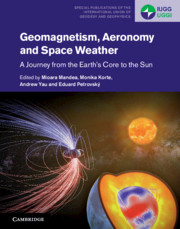Book contents
- Geomagnetism, Aeronomy and Space Weather
- Special Publications of the International Union of Geodesy and Geophysics Series
- Geomagnetism, Aeronomy and Space Weather
- Copyright page
- Contents
- Contributors
- Preface
- Part I Introduction
- Part II Geomagnetic Field
- Part III Spatial and Temporal Variations of the Geomagnetic Field
- Part IV Space Weather
- 14 Physical Processes of Space Weather
- 15 Space Weather Effects in the Ionosphere, in the Thermosphere and at Earth’s Surface
- 16 Technological Impacts of Space Weather
- Part V Magnetic Fields beyond the Earth and beyond Today
- Index
- References
16 - Technological Impacts of Space Weather
from Part IV - Space Weather
Published online by Cambridge University Press: 25 October 2019
- Geomagnetism, Aeronomy and Space Weather
- Special Publications of the International Union of Geodesy and Geophysics Series
- Geomagnetism, Aeronomy and Space Weather
- Copyright page
- Contents
- Contributors
- Preface
- Part I Introduction
- Part II Geomagnetic Field
- Part III Spatial and Temporal Variations of the Geomagnetic Field
- Part IV Space Weather
- 14 Physical Processes of Space Weather
- 15 Space Weather Effects in the Ionosphere, in the Thermosphere and at Earth’s Surface
- 16 Technological Impacts of Space Weather
- Part V Magnetic Fields beyond the Earth and beyond Today
- Index
- References
Summary
Over the past decade, policy-makers around the world have recognised that space weather is a natural hazard that poses a significant risk to modern societies. This chapter outlines how this risk has gradually developed over nearly 200 years through impacts on technological systems, and now affects a diverse set of technologies, including systems vital to provision of power, transport and communications. It illustrates the importance of these impacts through detailed examination of some key impact areas, looking at the physics that creates these impacts as well their societal consequences. The areas examined include (a) the impact of geomagnetically induced currents on electrically-grounded infrastructures such as electric power grids and railway track circuits, (b) the disruption of satellite navigation by space-weather-induced changes in the upper atmosphere, and (c) the impact of space radiation on satellites, on aircraft and on ground systems. A final section reviews our wider knowledge of space weather impacts and discusses how this can be applied, and improved, to meet future challenges. It stresses the need for improved socio-economic assessments of space weather impacts to aid decision-making and, in particular, to assess the value of investment in improved forecasting and other systems for mitigation.
Keywords
- Type
- Chapter
- Information
- Geomagnetism, Aeronomy and Space WeatherA Journey from the Earth's Core to the Sun, pp. 251 - 264Publisher: Cambridge University PressPrint publication year: 2019
References
- 5
- Cited by

